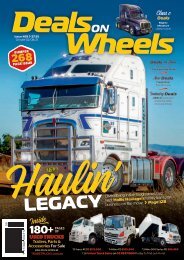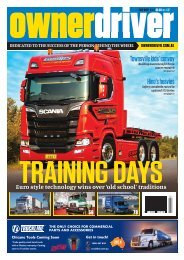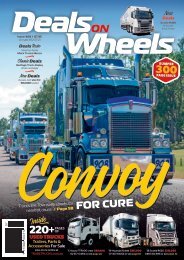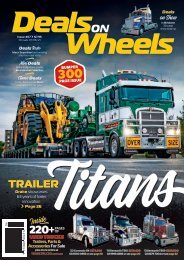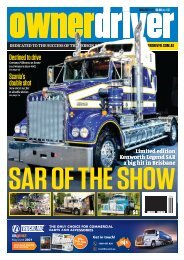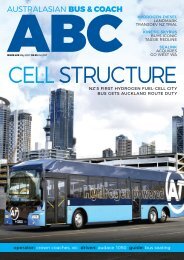Create successful ePaper yourself
Turn your PDF publications into a flip-book with our unique Google optimized e-Paper software.
the heavier-duty Allison 4440 series<br />
six-speed automatic.<br />
In the 13-litre class, the revamped<br />
range starts with the SH 1845 4x2<br />
model powered by Hino’s E13C<br />
dispensing 331kW (450hp) and<br />
2,157Nm of torque.<br />
All other 13-litre models – the<br />
high-roof SS 2848 6x4 prime mover,<br />
the FS 2848 6x4 rigid and the FY<br />
3248 eight-wheeler – have the<br />
engine rated to existing performance<br />
peaks of 353kW (480hp) and<br />
2,157Nm of torque, though Hino<br />
points out that peak torque is now<br />
dispensed across a wider 1,000 to<br />
1,500rpm rev range.<br />
Coupled to all 13-litre variants<br />
is the ZF Traxon 16-speed AMT,<br />
with forward, neutral and reverse<br />
controlled through a rotary<br />
dash-mounted shift knob; uncannily<br />
similar to Traxon installations in<br />
MAN models. The knob also controls<br />
a ‘slow mode’ for crawling.<br />
Furthermore, says Hino:<br />
“The dash-mounted selector is<br />
complemented by a sequential-type<br />
shift lever on the steering column<br />
that allows the driver to switch<br />
between automatic and manual<br />
modes, and manually select gears.”<br />
Also part of the AMT package is<br />
Hino’s Easy Start (hill hold) system<br />
for smooth lift-offs on grades.<br />
The list of standard features in the<br />
new range is undeniably impressive<br />
and includes alloy wheels in an<br />
obvious move to improve both tare<br />
weight and aesthetics.<br />
Much like its light- and<br />
medium-duty siblings, though, some<br />
of the most notable advances in<br />
Hino’s vastly upgraded 700-series<br />
have been in the deployment of<br />
advanced safety systems.<br />
SAFETY FIRST<br />
Hino is adamant its new 700-series<br />
range comprises the safest trucks<br />
Opposite<br />
from top:<br />
Hino Australia<br />
product strategy<br />
manager Daniel<br />
Petrovski. Among<br />
an extended<br />
700-series model<br />
range is a new<br />
eight-wheeler<br />
offering a nineor<br />
13-litre Euro<br />
6 engines. But<br />
the big gain for<br />
Hino’s 8x4 is<br />
a loadsharing<br />
twin-steer.<br />
Finally!; Modern<br />
makeover.<br />
Vastly upgraded<br />
700-series<br />
takes its interior<br />
design cues from<br />
its 500-series<br />
medium-duty<br />
stablemate<br />
which has<br />
enjoyed positive<br />
driver feedback.<br />
Function and<br />
form rate high<br />
in Hino’s new<br />
flagship range<br />
Below: Cummins<br />
Engine Company<br />
founder Clessie<br />
Cummins. In<br />
retirement in<br />
1955, he found<br />
the time to create<br />
the design that<br />
would become<br />
the remarkably<br />
effective Jake<br />
brake<br />
Every model in the<br />
expanded range is fitted<br />
with either an automated<br />
manual transmission or an<br />
Allison automatic<br />
HAPPY BIRTHDAY, JAKE<br />
Hiding in the shadows of Hino’s preview of its new 700-series trucks, and the<br />
use of a Jacobs engine brake in all models, is the fact that 2021 marks the 60th<br />
anniversary of Jacobs Vehicle Systems.<br />
Jacobs introduced the first engine brake for commercial vehicles in 1961 and,<br />
since then, more than nine million Jake brakes have been produced for trucks<br />
around the world.<br />
In fact, Jacob engine brake use has grown markedly over the past few years. The<br />
company sold its eight millionth engine brake in 2019 but it was only two years<br />
later, in March 2021, that the nine millionth unit rolled off the Jacobs assembly line.<br />
It may, however, surprise more than a few people to learn that the world’s best<br />
known engine retarder was actually invented by Clessie Cummins, the man who, in<br />
1919, founded the Cummins Engine Company. And it may also be a surprise to learn<br />
that safety and a near-death experience were the reasons why Cummins made an<br />
effective engine brake one of his most enduring engineering legacies.<br />
The story goes that, in 1955, when Cummins retired from the engine company<br />
he’d created, his thoughts returned to a terrifying experience in the northern<br />
summer of 1931, when he and two colleagues drove a Cummins diesel-powered<br />
truck from New York to Los Angeles in an attempt to set a new truck speed record<br />
across mainland USA.<br />
On the fifth day of the drive, at the top of a notorious pass on a stretch of historic<br />
Route 66 in Southern California, Cummins was at the wheel of the truck when it<br />
started a long, steep descent towards the San Bernardino Valley.<br />
On a gravel road that plunged downwards for 35 miles (55km), criss-crossed<br />
by a busy railway line, the frequent slowing for twists and turns overheated<br />
the truck’s brakes. Cummins tried to restrain the runaway truck with engine<br />
compression but, with so much momentum and road speed, was unable to engage<br />
a lower gear than third. To his horror, the Cummins founder realised he “would just<br />
have to ride it out”.<br />
With a freight train cutting across their path a short distance ahead, he was sure<br />
his days were done.<br />
Cummins later recounted how the truck passed the back of the train with inches<br />
to spare and how he had vowed that someday, somehow, he would make his engine<br />
work just as well going downhill as it did uphill.<br />
Almost 25 years passed before Cummins found the time in retirement to study<br />
what might be done to turn his engine into an effective brake. By 1957, he’d<br />
developed a design that would revolutionise engine braking. His idea was to take<br />
advantage of perfectly timed motion already built into Cummins and Detroit Diesel<br />
engines, which have a third cam on the main camshaft that activates the fuel<br />
injector of each cylinder. By transferring this motion to open the exhaust valve with<br />
a simple retrofit mechanism, the engine brake was born.<br />
Although the principal of engine braking wasn’t new, the details of Cummins’<br />
new technical approach made it novel enough to be granted patent protection.<br />
As for getting his engine brake into the market, it wasn’t plain sailing. Cummins<br />
was contractually obliged to offer his invention first to Cummins Engine Co. But,<br />
strangely, his design was rejected on the grounds of commercial risk. Big mistake!<br />
Fortunately, Cummins received a more positive response when he explained his<br />
idea to a vice-president of Jacobs Manufacturing Company. By April 1960, after<br />
the success of extensive tests of the design, Jacobs established a new Clessie L.<br />
Cummins Division (now named Jacobs Vehicle Systems) for the manufacturer of<br />
the engine brake.<br />
The rest, of course, is history and, while the raucous bark of earlier Jakes has<br />
been criticised by many,<br />
the one salient fact<br />
that can’t be criticised<br />
is the engine brake’s<br />
inestimable contribution<br />
in keeping truck drivers<br />
and other road users<br />
safe on downhill grades.<br />
Besides, the modern<br />
Jake is far quieter than<br />
its forebears, thanks<br />
to the fact that Jacobs<br />
Vehicle Systems<br />
engineers continue<br />
to work closely with<br />
engine manufacturers<br />
throughout the world,<br />
not least Hino.<br />
FULLYLOADED.COM.AU July 2021 <strong>ATN</strong> 53




